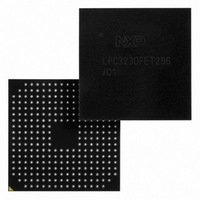LPC3230FET296/01,5 NXP Semiconductors, LPC3230FET296/01,5 Datasheet - Page 14

LPC3230FET296/01,5
Manufacturer Part Number
LPC3230FET296/01,5
Description
IC ARM9 MCU 256K 296-TFBGA
Manufacturer
NXP Semiconductors
Series
LPC32x0r
Specifications of LPC3230FET296/01,5
Package / Case
296-TFBGA
Core Processor
ARM9
Core Size
16/32-Bit
Speed
266MHz
Connectivity
EBI/EMI, I²C, IrDA, Microwire, SPI, SSI, SSP, UART/USART, USB OTG
Peripherals
DMA, I²S, LCD, Motor Control PWM, PWM, WDT
Number Of I /o
51
Program Memory Type
ROMless
Ram Size
256K x 8
Voltage - Supply (vcc/vdd)
0.9 V ~ 3.6 V
Data Converters
A/D 3x10b
Oscillator Type
Internal
Operating Temperature
-40°C ~ 85°C
Processor Series
LPC32
Core
ARM926EJ-S
Data Bus Width
32 bit
Data Ram Size
256 KB
Interface Type
EMC
Maximum Clock Frequency
266 MHz
Number Of Timers
6
Operating Supply Voltage
1.31 V to 1.39 V
Maximum Operating Temperature
+ 85 C
Mounting Style
SMD/SMT
3rd Party Development Tools
MDK-ARM, RL-ARM, ULINK2
Minimum Operating Temperature
- 40 C
On-chip Adc
10 bit, 3 Channel
Lead Free Status / RoHS Status
Lead free / RoHS Compliant
Eeprom Size
-
Program Memory Size
-
Lead Free Status / Rohs Status
Lead free / RoHS Compliant
Other names
568-4964
935290764551
935290764551
Available stocks
Company
Part Number
Manufacturer
Quantity
Price
Company:
Part Number:
LPC3230FET296/01,5
Manufacturer:
NXP Semiconductors
Quantity:
10 000
NXP Semiconductors
ES_LPC3230
Errata sheet
3.9 HSUART.1: High speed UART receive FIFO and status can freeze
Introduction:
The three high speed UART's (HSUART) receive (RX) FIFOs can sometimes enter a state
where they no longer accept received data. When this state occurs, the HSUART's RX
FIFO will no longer accept data regardless of RX FIFO fill status. The receive state of the
HSUART may indicate a number of possible, but invalid, receive statuses. These invalid
statuses may include RX FIFO or timeout interrupts pending with no receive data in the
RX FIFO, invalid RX FIFO status, stuck RX interrupts, or other possible RX statuses.
Once the HSUART enters this state, the state can only be cleared by a chip reset. This
applies to the U1_RX, U2_RX, and U7_RX pins. The HSUART's transmit side is not
affected by this issue and will work as normal when the HSUART receive side stops. The
four standard UARTs do not exhibit this behavior.
Problem:
It has been determined that this failed receive state can be entered by receiving a burst of
high frequency noise into the HSUART RX pin. High frequency noise consists of pulsed or
random toggling of the HSUART RX line at about 2.5 MHz or greater. The chance of the
HSUART entering the state increases with the number of pulses and frequency of the
pulses received. Generally, a single pulse won't cause the state to occur.
During normal data transfer with transfer rates 2400 bps (416 uS) to 921.6 Kbps
(1.085 uS), this state won't occur. However, conditions outside the transfer itself may
cause the state to occur. It has been observed in some systems that insertion of the serial
cable into the board's serial connector can cause connection noise or oscillations on the
transceiver. This noise is driven onto the HSUART RX pin from the transceiver as a series
of random pulses.
Work-around:
If all 7 UARTs aren't needed or 921.6 Kbps transfer rate isn't needed, use the standard
UARTs instead of the high speed UARTs to avoid the issue altogether. For systems that
require the HSUARTs, care must be taken to limit the exposure of the HSUART RX signal
for the type of signal conditions that can cause the state to occur. There are several
possible solutions that can help reduce the state from occurring.
Whenever the HSUART is not in use, place the HSUART into loopback mode. When in
loopback, the RX pin is connected internally to the HSUARTs TX pin and is isolated from
the external RX input. While in this loopback state, the condition won't occur on the
HSUART regardless of the signal on the RX input. The HSUART TX pin will remain in the
idle state in loopback mode when no data is being sent from the HSUART.
Optionally, if the HSUART is connected to a transceiver that supports enabling and
disabling of the input signal from the transceiver RX input to the transceiver RX output to
the HSUART RX input, disable it when not expecting a transmission. Regardless of how
the transceiver is connected to the RX pin, the RX pin should be prevented from floating at
power-up, reset, or when the transceiver is disabled. This can be done by adding a pull-up
resistor to the HSUART RX pin.
If using a system where the HSUART always need to be enabled, consider adding the
capability to sense when the cable has been plugged into the connector and switch the
HSUART out of loopback mode only once the cable has been installed to prevent cable
insertion noise.
All information provided in this document is subject to legal disclaimers.
Rev. 8 — 1 February 2011
ES_LPC3230
Errata sheet LPC3230
© NXP B.V. 2011. All rights reserved.
14 of 17













